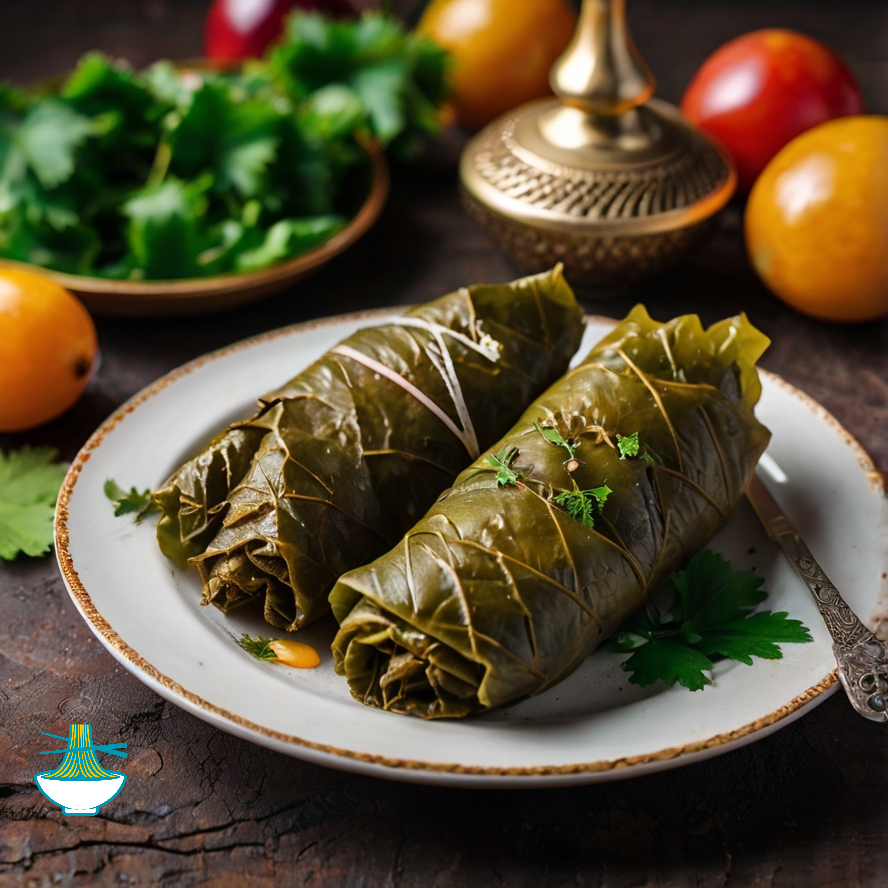Indulge in the flavors of Jordan with Warak Enab, a traditional dish featuring tender grape leaves filled with a tantalizing blend of rice, tomatoes, onions, and aromatic herbs. Slow-cooked to perfection in a tangy sauce, each bite offers a burst of Middle Eastern essence, bringing warmth and richness to your table. Experience the culinary heritage of Jordan in every savory mouthful of these exquisite stuffed grape leaves.
Ingredients:
For the stuffed grape leaves:
- 1 jar of grape leaves, rinsed and drained
- 1 cup of long-grain rice, rinsed
- 1 medium onion, finely chopped
- 2 tomatoes, finely diced
- 2 tablespoons of fresh parsley, chopped
- 2 tablespoons of fresh mint, chopped
- 2 cloves of garlic, minced
- 1/4 cup of olive oil
- Salt and pepper to taste
For the tangy sauce:
- 2 cups of water
- 1/4 cup of lemon juice
- 2 tablespoons of olive oil
- 1 tablespoon of tomato paste
- Salt and pepper to taste
Instructions:
1- Prepare the grape leaves by rinsing them thoroughly under cold water to remove any brine or excess salt. Drain and set aside.
2- In a mixing bowl, combine the rice, chopped onion, diced tomatoes, parsley, mint, minced garlic, olive oil, salt, and pepper. Mix well to ensure all ingredients are evenly distributed.
3- Take one grape leaf at a time and place it flat on a clean surface, vein side up. Trim any tough stems if necessary. Spoon about a tablespoon of the rice mixture onto the center of the leaf.
4- Fold the bottom edge of the leaf over the filling, then fold the sides inward, and roll tightly to form a neat cylinder. Repeat this process with the remaining grape leaves and rice mixture.
5- Arrange the stuffed grape leaves in a large pot, seam side down, packing them tightly together to prevent them from unraveling during cooking.
6- In a separate bowl, prepare the tangy sauce by mixing together water, lemon juice, olive oil, tomato paste, salt, and pepper. Pour the sauce over the stuffed grape leaves in the pot.
7- Place a heatproof plate or a layer of grape leaves on top of the stuffed leaves to weigh them down and keep them submerged in the sauce.
8- Cover the pot and bring it to a gentle simmer over medium heat. Reduce the heat to low and let the stuffed grape leaves cook for about 45-50 minutes, or until the rice is tender and the leaves are cooked through.
9- Once cooked, remove the pot from the heat and let the stuffed grape leaves cool slightly before serving.
10- Serve the Warak Enab warm or at room temperature, drizzled with some of the tangy sauce from the pot. Enjoy the delicious flavors of Jordanian cuisine!
Nutritional Values :
Here’s the nutritional breakdown and benefits for the ingredients in your stuffed grape leaves recipe:
For the Stuffed Grape Leaves:
Grape Leaves (1 jar, rinsed and drained):
- Calories: Approximately 50 (for 10 leaves)
- Fat: 0.5 grams
- Carbohydrates: 10 grams
- Protein: 1 gram
Benefits: Low in calories, high in fiber, and provides some vitamins and minerals. Supports digestion and adds a unique flavor.
Long-Grain Rice (1 cup):
- Calories: Approximately 200
- Fat: 0.4 grams
- Carbohydrates: 45 grams
- Protein: 4 grams
Benefits: Provides energy through carbohydrates and offers some protein.
Onion (1 medium, finely chopped):
- Calories: Approximately 45
- Fat: 0 grams
- Carbohydrates: 11 grams
- Protein: 1 gram
Benefits: Contains antioxidants and compounds that support heart health and reduce inflammation.
Tomatoes (2, finely diced):
- Calories: Approximately 44
- Fat: 0.4 grams
- Carbohydrates: 10 grams
- Protein: 2 grams
Benefits: Rich in vitamins A and C, and antioxidants like lycopene. Supports heart health and skin health.
Fresh Parsley (2 tablespoons, chopped):
- Calories: Approximately 5
- Fat: 0 grams
- Carbohydrates: 1 gram
- Protein: 0.5 grams
Benefits: Provides vitamins A, C, and K, adds freshness, and supports overall health.
Fresh Mint (2 tablespoons, chopped):
- Calories: Approximately 6
- Fat: 0 grams
- Carbohydrates: 1 gram
- Protein: 0.3 grams
Benefits: Adds flavor and freshness, supports digestion, and may have soothing properties.
Garlic (2 cloves, minced):
- Calories: Approximately 10
- Fat: 0 grams
- Carbohydrates: 2 grams
- Protein: 0.5 grams
Benefits: Known for its antibacterial and antiviral properties, boosts the immune system, and supports cardiovascular health.
Olive Oil (1/4 cup):
- Calories: Approximately 480
- Fat: 56 grams
- Carbohydrates: 0 grams
- Protein: 0 grams
Benefits: Provides healthy monounsaturated fats and antioxidants. Supports heart health and adds richness.
Salt and Pepper (to taste)
- Calories: 0
- Fat: 0 grams
- Carbohydrates: 0 grams
- Protein: 0 grams
Benefits: Enhances flavor. Salt helps maintain fluid balance, while pepper adds additional flavor and may have antioxidant properties.
For the Tangy Sauce:
Water (2 cups):
- Calories: 0
- Fat: 0 grams
- Carbohydrates: 0 grams
- Protein: 0 grams
Benefits: Used as a base for the sauce, does not contribute calories or nutrients.
Lemon Juice (1/4 cup):
- Calories: Approximately 12
- Fat: 0 grams
- Carbohydrates: 3 grams
- Protein: 0 grams
Benefits: Adds tangy flavor and vitamin C, supports immune function.
Olive Oil (2 tablespoons):
- Calories: Approximately 240
- Fat: 28 grams
- Carbohydrates: 0 grams
- Protein: 0 grams
Benefits: Provides healthy fats and supports heart health.
Tomato Paste (1 tablespoon):
- Calories: Approximately 15
- Fat: 0 grams
- Carbohydrates: 4 grams
- Protein: 0.5 grams
Benefits: Adds concentrated tomato flavor and some antioxidants.
Salt and Pepper (to taste):
- Calories: 0
- Fat: 0 grams
- Carbohydrates: 0 grams
- Protein: 0 grams
Benefits: Enhances flavor and helps maintain fluid balance.
These values are approximate and can vary slightly based on factors such as variety, ripeness, and cooking methods.


Comments